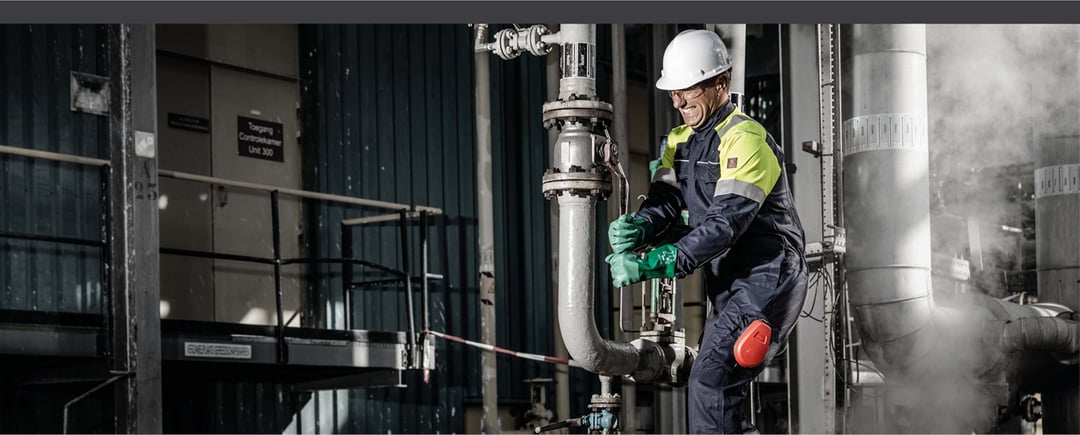Hard-working by nature, multi-risk industrial safety garments protect their wearers from a host of risks on the job. One of the most common is chemical splash. Protecting the skin from chemicals and toxic substances such as fuels, oils, or acids is essential in a high-risk work environment, since they can cause skin irritation, permanent tissue damage or life-threatening burns in the event of an accident. To provide effective chemical splash protection, our fabrics include a fluorocarbon finish which renders them water-repellent, oil-repellent, and chemical-resistant. Reapplying the finish after each wash cycle is essential to keep the garment’s protective properties intact (and keep them EN13034 certified).
Reapplying fluorocarbon finish to your garments
Motivated to protect their investment in quality industrial workwear, end users regularly reach out to TenCate Protective Fabrics for more information on how to maintain their garments’ chemical splash protection. While we neither supply fluorocarbon reapplication agents nor perform the finish reapplication, we certainly have the inhouse fabric expertise to provide recommendations on the process. Here are 8 tips to keep your protective workwear’s fluorocarbon finish in fighting shape.
- Frequent reapplication
Apply a fluorocarbon product to restore the repellency of the fluorocarbon finish during each washing cycle. Otherwise, the fabric’s repellent properties will decrease after a number of washes.
- Professional reapplication
Reapplying the fluorocarbon finish to fabric in a home laundry is not usually possible — leave the job to an industrial laundry, please! Besides managing the process up to industry norms, industrial laundries will ensure the fabrics have the correct pH level when reapplying the finish. To ensure the optimum effect, please also consult with your detergent manufacturer.
- Wash each type of fabric separately
Different fibre blends can require different washing programmes, as certain fabrics absorb more moisture than others. Regardless of the washing programme, always use anionic detergent. (Non-ionic detergents are more difficult to remove in the rinsing process.)
- Rinsing
Proper rinsing is crucial to remove all traces of detergent, as residue can have a negative effect on the fabric’s repellent properties and ability to take the fluorocarbon product. Rinse the garments between washing and reapplication of the finish, and spin well to get the contaminated water out of the fabric.
- Bleach
Avoid using if possible. The use of bleach (or hydrogen peroxide) can affect fabric colour and strength.
- Wash temperature
Our fabrics can be washed at temperatures up to 75°C. The higher the temperature, the more effective the cleansing of heavily-soiled garments. With frequent laundering, however, hot washes may affect the colour-fastness and appearance of the garment.
- Drying & reactivating
Drying is a crucial step in the reapplication process, as heat is required to achieve optimal reactivation of the finish. It’s important to ensure that protective workwear fabrics with fluorocarbon finish are completely dry after tunnel finishing or tumble drying. Drying time depends on the type of product used. However, avoid overdrying which may damage the fabric and cause excessive shrinkage. - Ironing
As mentioned above, applying heat has a positive effect on the reactivation of the fluorocarbon finish.
Protecting your protective workwear
In the interest of taking the best care possible of your protective garments, we urge our end users to first perform a workplace risk analysis. This will help you decide if chemical splash protection is something your garments should provide. If so, the next step is to confirm that your industrial laundry’s washing and finish reapplication protocols are in accordance with industry norms. Performing the reapplication process correctly takes care; simply washing a garment improperly can damage its fluorocarbon finish. That’s why it’s crucial for laundries to get the process right.
Looking for further advice on the care and maintenance of your protective workwear, or the risks involved with chemical splash? Please reach out to our product specialists. They’re always happy to help answer any questions you might have.



![FR Fabrics Guide [EN]](https://eu.tencatefabrics.com/hs-fs/hubfs/EU%20-%20Images%20website/EU%20-%20Mock-up%20nieuwe%20afmetingen/FR%20Fabrics%20Guide%20%5BEN%5D.png?width=170&name=FR%20Fabrics%20Guide%20%5BEN%5D.png)



.png?width=399&name=Risk%20management%20for%20PPE%20clothing%20in%20the%20EV%20and%20battery%20industries%20(5).png)
